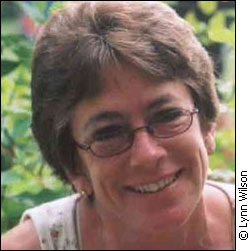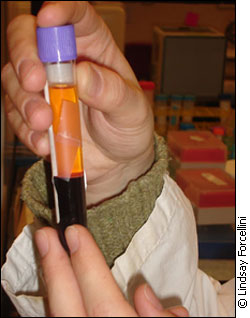
|
"It was a crazy frenzy in there," she recalls. "But the smallest size they had was a seven – so I didn't even bother." Prepared to walk away from the summer sale empty-handed, Jones said her partner suggested they check out the kids section for a suit that might fit. She decided to give it a shot and hid in the change rooms while he ran back and forth searching for suits without Pochahontas or Mickey Mouse on them. And it was there, in the kids section, that Jones found the perfect-fitting bathing suit. " It wasn’t the most 'sexy' suit," she laughs, "but it fit."
Jones stands five-feet-four-inches tall, and she weighs the same as she did when she was eighteen years old – 100 pounds. At a size zero, one might think Jones could slip into the latest fashions with ease, but this is not the case. Jones can find clothes that fit, but nothing fits well. The legs are too short at petite stores, the fashions are too young at stores like Le Chateau, and a size zero in one store, isn't a size zero in another. The result? Baggy shoulders, extra-long sleeves and clothes that just don’t fit her tiny frame. "I feel like a little kid, dressing up in my mom’s clothes," she says. Jones has always been thin – and that's why researchers are now turning to people like her to find out more about obesity. Obesity is a growing problem in our society but much about this condition still remains a mystery – mainly its cause. It is a condition that occurs when one's weight is greater than the range normally considered healthy for a given height. An adult that has a body mass index of 30 or greater is considered obese. Body mass is a measure of body fat based on weight and height. Obesity: lifestyle or genetics? Many cases of obesity and other weight-related ailments are directly related to one's eating and physical activity habits – consuming more calories than one is expending, but in other cases, there seems to be something else at play. Dr. Ruth McPherson and her team of researchers at the Lipid Research Laboratory in the University of Ottawa Heart Institute are focusing their energies on identifying and exploring the genetic differences between thin and obese people. The Thin Gene Study, which began in 2002, monitors 1000 obese people and 1000 thousand thin people over a five-year period. Sybil Hebert, research coordinator says this obesity study is the first of its kind to focus on thin people. Dr. McPherson agrees. She is active in clinical research in the areas of coronary heart disease, and the genetics behind obesity and obesity resistance. The study looks at what Dr. McPherson calls extreme phenotypes, or individuals who are afflicted with severe obesity early on and those individuals who seem to be protected from the disease altogether. Her interest in taking the genetic component of obesity one step further came from something many people can likely relate to – observing the "lucky" individuals who seem to be able to eat anything they want, and not gain any weight, while observing other people who may eat the same amount as a thin person, or even less, and yet still gain weight continuously. " I have worked with many overweight people, and it was obvious that [they were not] just lazy or that they overate. It was extremely difficult for some people," explains Dr. McPherson. "I think that it’s a very useful approach to study extreme opposites, and it's likely to be the most fruitful." Genetic junk in the trunk The goal of the Thin Gene Study is to identify the genetic differences between obese and thin individuals says Hebert, and isolate the genes responsible for thinness and those responsible for obesity. The study was limited to Caucasian people, because there are genetic differences between ethnicities. They recruited local people, over the age of 18, who were lean for most of their life. For the purposes of this study, lean refers to those individuals with a body mass index below 19 and with a weight percentile of fourteen of below. Weight percentile compares an individual's weight compared with everyone else. For example, a weight percentile of forty, means that you are heavier than forty out of one hundred people of your age and height, or sixty per cent of others weigh more than you. The study was open to both athletes (individuals who engage in intense exercise for ten or more hours per week) and non-athletes and Hebert says they screened to eliminate those who might have suffered from an eating disorder, depression, or psychosis. The lean participants were carefully matched according to the age and gender of the obese participants, who were recruited from the institute's Weight Management Clinic. The average age was 43, and 60 per cent of the participants were female. The lean recruits, like Sandra Jones, filled out questionnaires, had their weight and measurements taken, and gave a blood sample. The study also included a family analysis, where they took blood from both parents or a parent and one sibling to look for similarities and differences. 100 individuals were selected to complete an additional component, in which they kept a detailed log of their diet and physical activity for three days, every six months. Healthy appetite Jones says she typically eats a large slice of homemade bread with butter and peanut butter for breakfast, a cheese bun with cheese and butter, and soup or salad, and two pieces of fruit for lunch, and what she calls a "man’s portion" of spaghetti or chicken and the fixings for dinner. "I don’t eat like a bird," laughs Jones. "But I'm not big into snacking – I only eat three meals a day." Jones, who leads a fairly active and busy life, says she can eat excessive amounts of junk food and her weight will stay the same. "It’s like my body burns a calorie the second it gets one."
Jones is certainly not alone in this study. Lynn Wilson is another lean participant. Like Jones, she has also dipped into the kids department to find clothes to fit her small frame. At five-foot-one, Wilson says she weighs between 95 and 98 pounds, and she has been the same weight since she was 16. She does not count calories, but says that she does not really get hungry often either. Instead, Wilson says she eats because she knows she should but when she does get hungry, she has to eat immediately, so she often grabs sweets because they're convenient. Wilson does not exercise regularly, but says her weight does not fluctuate depending on what she eats. "I ate my way through Mexico, big breakfasts, and Pina Coladas every day," she laughs. "Eat good, eat bad, eat, don’t eat…it doesn’t seem to matter." DNA extration Researchers took the blood from participants like Wilson and Jones and extracted their DNA before beginning gene sequencing. They first processed the blood in a centrifuge to separate the plasma and red blood cells from what is known as the buffy coat, says Nihan Karaslar, a research assistant who works in the lab. Karaslar says the buffy coat contains the nucleus and DNA. Once the DNA is extracted, the researchers take a portion of the genome and amplify it, to mimic DNA replication, so there is more of it to work with.
Dr. McPherson says they will look at the coding of the gene sequences that regulate food intake and energy consumption and study variances to see if they are associated with leanness or obesity in the family. The team has just started sequencing for the first 500 obese and thin people. Hebert says sequencing takes about a year to complete. Because sequencing is still ongoing, Dr. McPherson and her research team do not have the results of the study at this time, but she said what they do know so far is that they are very interested in a couple of particular genes because of their potential for protecting against obesity. One of these genes is the Sim 1 gene. Dr. McPherson also adds that they have identified two sequence variances that that are associated with leanness. They are conducting an in-house study to look at mutations in proteins like PYY (Peptide YY) MC4R and MEF2A that are linked to obesity-related diseases. In the meantime, Dr. McPherson is optimistic about the Thin Gene Study and its potential to help obese people. With this research, the team is hoping to take a preventative approach and isolate a gene that might predispose people to obesity so genetic screening can take place. They also hope the "thin gene" can prove useful in possibly treating those suffering from obesity. " We want to identify the group that is genetically at risk," says Dr. McPherson. "We have to understand the genetics and biology of obesity in order to treat it."
|
|
|


